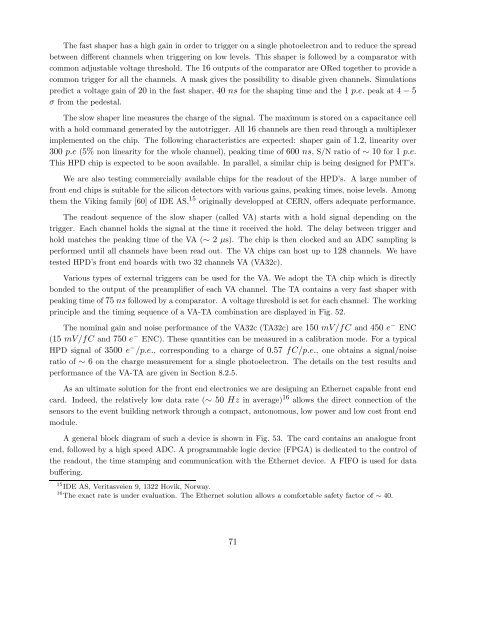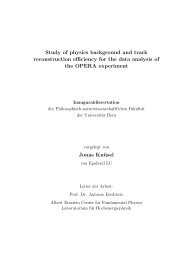Experiment Proposal - opera - Infn
Experiment Proposal - opera - Infn
Experiment Proposal - opera - Infn
Create successful ePaper yourself
Turn your PDF publications into a flip-book with our unique Google optimized e-Paper software.
The fast shaper has a high gain in order to trigger on a single photoelectron and to reduce the spread<br />
between different channels when triggering on low levels. This shaper is followed by a comparator with<br />
common adjustable voltage threshold. The 16 outputs of the comparator are ORed together to provide a<br />
common trigger for all the channels. A mask gives the possibility to disable given channels. Simulations<br />
predict a voltage gain of 20 in the fast shaper, 40 ns for the shaping time and the 1 p.e. peak at 4 − 5<br />
σ from the pedestal.<br />
The slow shaper line measures the charge of the signal. The maximum is stored on a capacitance cell<br />
with a hold command generated by the autotrigger. All 16 channels are then read through a multiplexer<br />
implemented on the chip. The following characteristics are expected: shaper gain of 1.2, linearity over<br />
300 p.e (5% non linearity for the whole channel), peaking time of 600 ns, S/Nratioof∼ 10 for 1 p.e.<br />
This HPD chip is expected to be soon available. In parallel, a similar chip is being designed for PMT’s.<br />
We are also testing commercially available chips for the readout of the HPD’s. A large number of<br />
front end chips is suitable for the silicon detectors with various gains, peaking times, noise levels. Among<br />
them the Viking family [60] of IDE AS, 15 originally developped at CERN, offers adequate performance.<br />
The readout sequence of the slow shaper (called VA) starts with a hold signal depending on the<br />
trigger. Each channel holds the signal at the time it received the hold. The delay between trigger and<br />
hold matches the peaking time of the VA (∼ 2 µs). The chip is then clocked and an ADC sampling is<br />
performed until all channels have been read out. The VA chips can host up to 128 channels. We have<br />
tested HPD’s front end boards with two 32 channels VA (VA32c).<br />
Various types of external triggers can be used for the VA. We adopt the TA chip which is directly<br />
bonded to the output of the preamplifier of each VA channel. The TA contains a very fast shaper with<br />
peaking time of 75 ns followed by a comparator. A voltage threshold is set for each channel. The working<br />
principle and the timing sequence of a VA-TA combination are displayed in Fig. 52.<br />
The nominal gain and noise performance of the VA32c (TA32c) are 150 mV/fC and 450 e − ENC<br />
(15 mV/fC and 750 e − ENC). These quantities can be measured in a calibration mode. For a typical<br />
HPD signal of 3500 e − /p.e., corresponding to a charge of 0.57 fC/p.e., one obtains a signal/noise<br />
ratio of ∼ 6 on the charge measurement for a single photoelectron. The details on the test results and<br />
performance of the VA-TA are given in Section 8.2.5.<br />
As an ultimate solution for the front end electronics we are designing an Ethernet capable front end<br />
card. Indeed, the relatively low data rate (∼ 50 Hz in average) 16 allows the direct connection of the<br />
sensors to the event building network through a compact, autonomous, low power and low cost front end<br />
module.<br />
A general block diagram of such a device is shown in Fig. 53. The card contains an analogue front<br />
end, followed by a high speed ADC. A programmable logic device (FPGA) is dedicated to the control of<br />
the readout, the time stamping and communication with the Ethernet device. A FIFO is used for data<br />
buffering.<br />
15 IDE AS, Veritasveien 9, 1322 Hovik, Norway.<br />
16 The exact rate is under evaluation. The Ethernet solution allows a comfortable safety factor of ∼ 40.<br />
71




